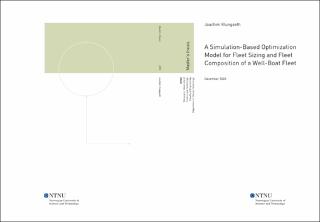| dc.contributor.advisor | Asbjørnslett, Bjørn Egil | |
| dc.contributor.author | Klungseth, Joachim | |
| dc.date.accessioned | 2021-09-24T16:56:33Z | |
| dc.date.available | 2021-09-24T16:56:33Z | |
| dc.date.issued | 2020 | |
| dc.identifier | no.ntnu:inspera:67623674:38078204 | |
| dc.identifier.uri | https://hdl.handle.net/11250/2781510 | |
| dc.description.abstract | Den norske oppdrettsindustrien har hatt en fabelaktig vekst de siste 20 årene og denne veksten er forventet å fortsett i flere tiår framover. Dette vil medføre et stort behov for nye brønnbåter, samt verktøy for å effektivisere brønnbåtoperasjoner.
Forskjellige optimeringsmetoder kan være til stor hjelp når flåtestørrelse og sammensetning skal bestemmes. Ved å kombinere simuleringsmodeller med optimeringsalgoritmer er det mulig å finne gode løsninger med minimal bruk av datakraft. Simuleringsbasert optimering tilbyr også en god løsning for å håndtere usikkerhet og stokastiske prosesser.
Meta heuristikker og stochastic adaptive search teknikker er pålitelige algoritmer til bruk i simuleringsbasert optimering. Stochastic adaptive search teknikker har beviselige convergens egenskaper og vil alltid nærme seg det globele optimum. meta heuristikker har ikke disse konvergens egenskapene men har i praksis vist seg å kunne fungere like godt.
For dette problemet har den genetiske algoritmen vist seg å kunne utkonkurrere de andre. På generell basis har de teknikkene som raskets kunne peile seg inn på et lovende område, også levert de beste resultatene. En grunn til dette kan være at løsningsområdet er dominert av ett globalt optimum. Derfor var det de algoritmene som først fant dette området og konsentrerte søket her, som også gjorde det best. LAST kom også godt ut.
Ved å gjennomføre en Pareto Front analyse og sette gode løsninger opp mot variansen, ble det vist liten korrelasjon mellom gode løsninger og høy varians. Dette er et godt resultat for alle stakeholderene, da de kan gå for beste løsning uten å gå på kompromiss med risiko villigheten.
Fullføringsraten på oppdrag for en gitt flåte viste seg å ha en sterk korrelasjon med styrken på løsningen. Dette virker igjen i favør av stakeholderene, da beste flåte kan velges uten å gå på kompromiss med andre interesser.
Den beste løsningen ble funnet av den genetiske algoritmen, med disse beslutningsvariablene: Flåtestørrelse 8, båttyper 1, 1, 1, 2, 2, 3, 5 og 5.
De andre algoritmene favoriserte også båttypene 1, 2 og 5, samt en flåtestørrelse på 7 eller 8 brønnbåter. Det at de mindre båtene ble foretrukket er ikke på linje med den nåværende trenden i markedet. Denne modellen er laget for spot markedet mens de fleste ny bygg blir prosjektert for lengere kontrakter. Dette kan forklare noe av forskjellen. | |
| dc.description.abstract | The Norwegian aquaculture industry has had a phenomenal growth over last decades and is expected to continue this growth during the next couple of decades. This will lead to a huge demand of new well-boats and increased need to streamline well-boat operations.
Different optimization techniques could be of huge help when making decisions regarding size and capabilities of the future well-boat fleet. By combining simulation models with optimization, it is possible to obtain a close to optimal solution with the minimal amount of computational time. Simulation-based optimization also offers a great way of dealing with uncertainties and stochastic processes.
Meta-heuristics and stochastic adaptive search techniques are reliable algorithms for simulation-based optimization. Stochastic adaptive search techniques will always converge towards the global optimum and given enough time, they always find a good estimation of the optimal solution. Meta-heuristics is not guaranteed to converge towards the global optimum, but in practice they have shown to be efficient tools for finding good solutions.
For this problem the genetic algorithm was proven to outperform the others. In general, the techniques that were quickest to narrow the search in on a promising area, gave the best results. A reason for this could be that the solution space has one dominant global optimum. The algorithms that finds this area relatively fast and stays there are also those who gives the best result. The genetic algorithm and the LAST does this and are also those who delivers the best solutions.
Performing Pareto Front analysis, the variance of the solution showed no sign of being correlated with the strength of the solution. This is a clear advantage for any stakeholder, as they could choose the best solution without compromising on risk tolerance.
The completage percentage for missions for a given fleet was one the other hand strongly correlated with the strength of the solution. Which again works in the favor of the stakeholder and reduces the amount of compromises needed.
The best solution found, came from the genetic algorithm, with these values for the decision variables: Fleet size 8, vessel types 1, 1, 1, 2, 2, 3, 5 and 5.
The other algorithms also favored vessel type 1, 2 and 5, and a fleet size of 7 or 8. That the smaller vessels are favored is not what the current market trend would suggest. Then again new builts are mainly projected for long term contracts while this model is aimed at the spot market. | |
| dc.language | eng | |
| dc.publisher | NTNU | |
| dc.title | A Simulation-Based Optimization Model for Fleet Sizing and Fleet
Composition of a Well-Boat Fleet | |
| dc.type | Master thesis | |
